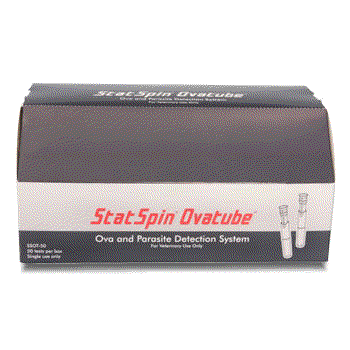Description
Ova and Parasite Detection System
In-Clinic Parasite Detection Test Kit
OvaTube is the ideal in-clinic parasite detection test kit which is suitable for companion and small animals and has been developed for use in veterinary hospitals, practices and reference laboratories. In a situation where an animal has internal parasites or a particular parasite, the concentration flotation technique is recommended. Particularly the centrifugal technique, for the maximum yield of ova and oocysts.
Worm Egg Detection Method For Companion And Small Animals
The basic principle uses a flotation solution of special Specific Gravity in which the faecal sample is mixed and poured into a centrifuge tube. This can then be incubated vertically on the bench for up to 10-15 minutes. However, it is proven that if the tube is centrifuged at slow speed for a few minutes, the accuracy is greatly improved. Importantly, centrifugation forces heavy debris to the bottom of the tube; allows flotation of the ova and prevents debris from obscuring the final microscopic examination. OvaTube together with our ready-made Vetlab Flotation Solution is ideal for performing both techniques. For complete F.E.C kits please see our Parasitology page.
OvaTube – The Perfect In-Clinic Solution: fast easy and clean
The StatSpin OvaTube is the first centrifugation method that is easy and fast without any mess, with a simple coring tool to obtain a sample. Just add the sample to the tube and mix with standard flotation fluid. Centrifuge in either a fixed angle or horizontal centrifuge, remove the tube, add a coverslip, and twist. In just a few minutes results are ready to read. OvaTube can also be used without a centrifuge…read on for further information.
More Info
OvaTube – Advantages
- Accurate in-clinic results (gold standard)
- Cost-effective
- Cleaner processing of samples
- 3-minute coverslip transfer for microscopic examination
- Fast results – Diagnose patients whilst they wait
- Standardises the method
Using StatSpin OvaTube without a Centrifuge
Follow the instructions carefully, then stand the OvaTube vertically in a rack for 10 -15 minutes.

Summary
Centrifugal flotation is recommended by the Companion Animal Parasite Council (CAPC) as the preferred method for routine screening of faecal samples for the detection of parasite ova. In addition, it is recommended that faecal examinations should be performed 2 – 4 times during the first year of life and 1 – 2 times per year in adult pets.
Instructions For Use
OvaTube Instructions For Use
OvaTube Instructions For Use
Flotation Solutions
Ready-Made Faecal Flotation Solutions
Made to your Specific Requirements (Sodium Nitrate & Zinc Sulphate)
Livestock & Companion Animals
Examination of faeces from livestock and companion animals for parasite eggs and oocysts is an important diagnostic procedure in most veterinary practices and laboratories. One of the most common techniques uses the concept of floating parasite eggs to the surface of a special solution in order to be detected under the microscope.
Specific Gravity
Basically, this is achieved by increasing the density or specific gravity (S.G.) by dissolving certain salts in water. The S.G has to be optimised in order to allow parasite eggs to float and faecal debris to sink. It is generally recognised that the S.G. of faecal flotation solutions should be within the range 1.18 to 1.27 to detect most (but not all) ova.
Vetlab Supplies Ready-made Faecal Flotation Solution
We offer ready-made faecal flotation solution of either Sodium Nitrate or Zinc Sulphate both of S.G of 1.200. These solutions are the most popular and recommended for general use. We offer both solutions to accommodate personal choice, although we find that our Sodium Nitrate Solution has less shrinkage effect on Giardia Cysts. However, we can make solutions of different S.G. values to personal order. These solutions are ideal for use with our ‘OvaTube’ and McMaster slides.
For further information follow this link
McMaster Slides
McMaster Worm Egg Counting Slides
McMaster worm egg counting slides are widely used for performing faecal worm egg counts in large animals such as horses, cattle and sheep in order to estimate intestinal parasite burdens and check worming efficacy.
Vetlab McMaster 2 Cell Counting Slide
Our McMaster Slides have some significant advantages compared to the conventional glass type.
- Made from the strongest optical acrylic available — which is more robust than glass.
- The upper section is fused to the lower section by sonic welding rather than glue. This makes the slide more durable and avoids faecal residue being trapped between the pieces.
- The upper section grids are printed in blue ink which lasts for some years with correct care. This allows the grid lines to be focused on more easily and worm eggs to be seen underneath the grid lines.
- The grids consist of 6 columns (instead of 9), the width of each column fitting exactly the field of view at x100 magnification, allowing counts to be performed faster.
- Our Vetlab McMaster slides are one-third of the cost of a conventional glass slide!
For further information follow this link



